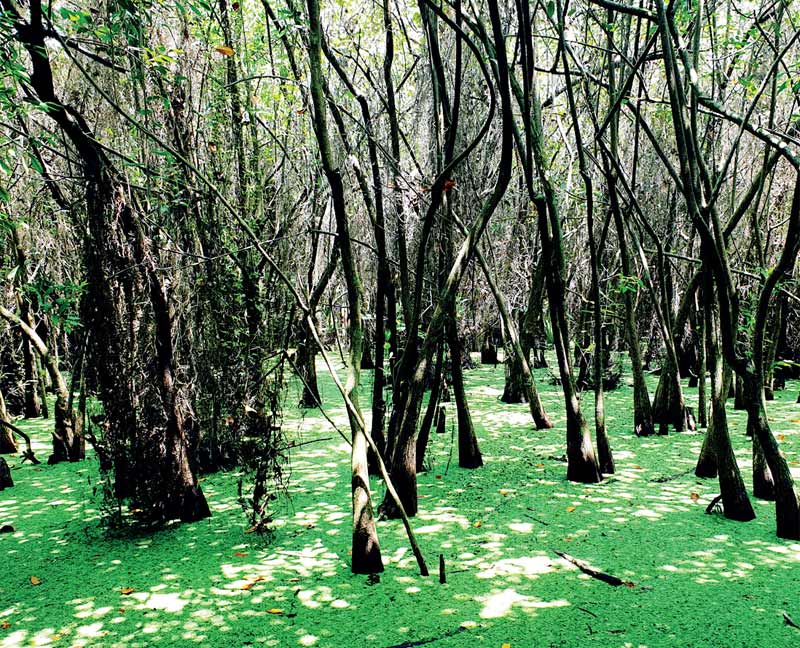Saturday Apr 19, 2025
Saturday Apr 19, 2025
Tuesday, 8 February 2022 00:00 - - {{hitsCtrl.values.hits}}

The impacts of climate change directly and indirectly threaten wetlands in Sri Lanka and across the world
 World Wetlands Day was celebrated around the globe on 2 February, sounding a call to action to value, manage, and restore critically important wetland ecosystems. Mostly due to human activity, wetlands have been destroyed or degraded at alarming rates, with approximately 35% of the world’s wetlands lost between 1970 and 2015. It is vital to understand the role these ecosystems play for the environment, biodiversity, the climate, and human communities, and take action to save them from disappearing.
World Wetlands Day was celebrated around the globe on 2 February, sounding a call to action to value, manage, and restore critically important wetland ecosystems. Mostly due to human activity, wetlands have been destroyed or degraded at alarming rates, with approximately 35% of the world’s wetlands lost between 1970 and 2015. It is vital to understand the role these ecosystems play for the environment, biodiversity, the climate, and human communities, and take action to save them from disappearing.
Wetlands can be described as areas where water either covers the soil or is present at its surface, defining its biogeochemistry and providing unique habitats for plants and animals. They form where water accumulates in depressions, where groundwater comes to the surface, or in transitional zones between terrestrial and aquatic ecosystems. Some wetlands are flooded year-round, others retain water in the soil and only flood due to seasonal rainfalls or the tides. From marshes to swamps, and from peatlands to mangrove forests, wetlands comprise a range of diverse ecosystems and host a rich biodiversity of plants and animals.
The Ramsar Convention on Wetlands of International Importance, which Sri Lanka ratified in 1990, summarises these criteria into the following definition: “[Wetlands are] areas of marsh, fen, peat land or water, whether natural or artificial, permanent or temporary with water that is static or flowing, fresh, brackish or salt, including areas of marine water the depth of which at low tide does not exceed six metres.”
Wetland ecosystems in Sri Lanka
Sri Lanka is home to many wetland ecosystems under the above definition, including coastal salt marshes, mangroves, seagrass beds, rivers, streams, freshwater swamp forests and marshes, flood plains, villus, lagoons, estuaries, paddy fields, reservoirs, tanks, and salt pans. The 1989 Asian Wetland Directory identified 41 wetland sites of international importance covering 274,000 hectares in the country, which was further solidified by the Central Environmental Authority’s 1999 Wetland Atlas of Sri Lanka.
Many Sri Lankan communities depend on or benefit from the products and services provided by wetland ecosystems. This includes water supply and transportation, flood mitigation and retention, control of coastal erosion, sediment retention, water purification and regulation, carbon sequestration, habitat for flora and fauna, recreation, tourism, and provisions of agricultural products, medicinal herbs, raw materials, hydroelectricity, fish and crustaceans, and salt. In addition to direct environmental and economic benefits, wetlands also provide many indirect advantages and hold significant cultural value, enhancing human wellbeing, safety, and quality of life.
However, wetlands also face serious threats, such as habitat degradation or deterioration, land reclamation, pollution and waste, loss of biodiversity, spread of invasive alien species, and climate change. Many wetland species of plants and animals are already endangered or threatened, and human activity as well as rises in ocean temperature, ocean acidification, sea level rise, changes in rainfall patterns, droughts, or storms can all have devastating impacts on the overall ecosystems.
Wetlands and climate change
The impacts of climate change directly and indirectly threaten wetlands in Sri Lanka and across the world. Extreme weather events and long-term climate processes can affect the integrity and balance of wetland ecosystems and cause them to deteriorate or be destroyed, affect communities that depend on them, and expose areas to greater climate risks by reducing flood and storm protection.
However, wetlands are not only sensitive to climate change but also one of the most potent tools available for both climate change mitigation and adaptation. When it comes to mitigation--i.e., the removal of carbon dioxide and other greenhouse gasses from the atmosphere--, wetlands are among the most efficient carbon sinks in the world. Hectare by hectare, they can store more tonnes of carbon in their soil and vegetation than almost any other ecosystem, several times as much as temperate forests, tropical forests, savannahs, grasslands, or croplands.
With regard to climate change, wetlands offer more than just their great mitigation capacity. Their variety of services and materials can help communities to withstand climate impacts in low-cost, natural ways and provide them more diverse and robust livelihoods. Mangrove forests, for example, protect coastlines and shield coastal communities from erosion, storms, flood surges, and even tsunamis. Urban wetlands can clean up polluted water, slow and store flood water, and serve as green infrastructure that reduces climate risks without requiring huge investments or maintenance. Other wetlands can recharge depleted groundwater and provide a water supply during droughts or support habitats for many species of economic importance.
A solution to the challenge of climate change
To protect wetlands, it is key to understand their importance, understand their role in hydrological and ecological cycles, and understand their significance for human communities and vulnerable groups, including issues related to sustainable development, livelihoods, food security, gender, or youth. Based on scientific understanding and evidence, wetlands can then be effectively protected, rehabilitated, and restored in collaboration with local stakeholders and the support of national policies, local and national plans, and international instruments such as the Ramsar Convention.
This World Wetland Day offers an opportunity to reflect on potential actions to enhance wetland conservation and spread awareness on their vast potential as climate solutions: for mitigation, for adaptation, for managing climate risks, for protecting biodiversity, and for building long-term resilience of humans, nature, and the planet.
(The writer works as Director – Research and Knowledge Management at SLYCAN Trust, a non-profit think tank based in Sri Lanka. His work focuses on climate change, adaptation, resilience, ecosystem conservation, just transition, human mobility, and a range of related issues. He holds a Master’s degree in Education from the University of Cologne, Germany and is a regular writer to several international and local media outlets.)
Discover Kapruka, the leading online shopping platform in Sri Lanka, where you can conveniently send Gifts and Flowers to your loved ones for any event including Valentine ’s Day. Explore a wide range of popular Shopping Categories on Kapruka, including Toys, Groceries, Electronics, Birthday Cakes, Fruits, Chocolates, Flower Bouquets, Clothing, Watches, Lingerie, Gift Sets and Jewellery. Also if you’re interested in selling with Kapruka, Partner Central by Kapruka is the best solution to start with. Moreover, through Kapruka Global Shop, you can also enjoy the convenience of purchasing products from renowned platforms like Amazon and eBay and have them delivered to Sri Lanka.
Discover Kapruka, the leading online shopping platform in Sri Lanka, where you can conveniently send Gifts and Flowers to your loved ones for any event including Valentine ’s Day. Explore a wide range of popular Shopping Categories on Kapruka, including Toys, Groceries, Electronics, Birthday Cakes, Fruits, Chocolates, Flower Bouquets, Clothing, Watches, Lingerie, Gift Sets and Jewellery. Also if you’re interested in selling with Kapruka, Partner Central by Kapruka is the best solution to start with. Moreover, through Kapruka Global Shop, you can also enjoy the convenience of purchasing products from renowned platforms like Amazon and eBay and have them delivered to Sri Lanka.